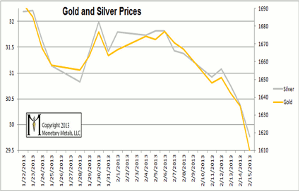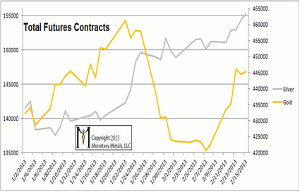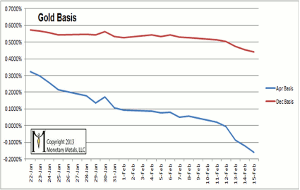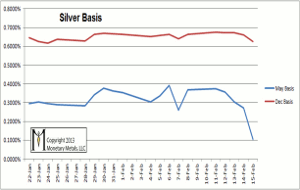There’s a bit of a mystery going on in the gold and silver markets, and Keith Weiner of monetary-metals.com offers a possible answer below.
A curious thing happened last week. The prices of both monetary metals have been falling for a week and a half through February 15. No, that's not the curious part. There is no law of nature that says the prices have to go up, but if they go down it must be artificial somehow. The curious thing is that the price fell while open interest in futures rose, which is not typical of how the market has actually been behaving in recent years. Now let's look at the data.
Silver (SLV) loses about 6.6%, and gold (GLD) about 4%; thus the gold:silver ratio gains about 2.6%. Next, let's look at the open interest data, which is the number of futures contracts in each metal.
One possible explanation is the notorious "naked short sellers". If so, they made money. Prices did fall. However, there is more data that doesn't quite fit this theory. As we showed, silver open interest was already quite high. It increased a few thousand contracts (under 2%) during the period through February 15. Gold open interest was not high by recent historical standards, and its open interest rose by 25,000 contracts (around 6%).
Now let's look at the basis data (here is a short tutorial on the basis). What is the gold and silver basis? Let's start with an oversimplified definition.
Basis = Future – Spot Cobasis = Spot – Future
What we are trying to see is a measure of scarcity. If the price in the spot market is higher than in the futures market (e.g. grain, one week before the harvest) then the good is scarce. If the price in the futures market is higher, then anyone can "carry" the good at a profit. To "carry" means to simultaneously buy the physical good and sell a futures contract against it. A positive basis means this is profitable. A positive cobasis means that it is profitable to "decarry": to simultaneously sell the good in the physical market and buy a futures contract. Both carry and decarry result in the same position at the end of the day plus the profit from the spread.
To be precise, we must define these terms in a more complex way. Of course, to buy something one must pay the "ask" or "offer". To sell, one must accept the bid. With that in mind, here are the correct definitions:
Basis = Future(bid) – Spot(ask) Cobasis = Spot(bid) – Future(ask)
Note that both can be negative (which often occurs as a contract is heading into expiry and there is no liquidity, hence the bid is very low and the ask is very high). At most, one of them can be positive. It can be profitable to carry a good, or to decarry it. But it makes no sense for it to be possible to carry profitably and decarry profitably! There is a lot more to the theory of why these spreads are important and what they mean. This adds additional color to the data provided above.
NEXT PAGE: Is Arbitrage the Answer?
|pagebreak|
The gold basis has been falling for a long time. The basis generally (but not always) moves in the opposite direction of the cobasis, and this showed the cobasis rising. The falling gold basis is not news in itself. Let's look at the silver basis.
The silver basis for December has been in a rising trend since at least last July (which uptrend is not yet broken, in our opinion). Here in this graph, we see it is not much changed from start to end. The May basis is falling, which is interesting as it occurs against the contract "roll" from March-May, now occurring. The "roll" is when "naked longs" must sell because they cannot take delivery, and typically they buy the next month if they want to keep exposure to the metal.
The above data shows: (1) falling prices, (2) rising open interest, and (3) falling basis in gold and slightly more ambiguously in silver. We have provided all of the data comprising this curious circumstance. You can form your own conclusion.
Earlier, we presented the data for gold and silver price, open interest, and basis. They form a curious combination, which we discuss below. If open interest is rising, then it means one of two things. Contracts are being created by fresh buyers taking the ask, in which case we should see prices rising. Or it could be that new sellers are selling on the bid, in which case we should see prices falling. Prices have been falling, so there are fresh new sellers. That would seem to be simple enough. Selling of futures will depress the basis.
In gold, this is straightforward. We see the basis for every contract month falling, which means the price in the futures market is falling relative to the price of gold in the physical, or spot, market. In silver, it's a little less clear. Other than the last two days, February 14 and 15, is not doing much falling. Could selling of physical been present to nearly match the selling of futures until the last two days?
Since January, we have been downright bearish on silver in gold terms and cautious on silver in dollar terms . What's curious about the falling gold price is that, unlike in silver, we saw little reason for physical gold to sell off and on Friday sounded the alarm bell about gold backwardation. So we have physical silver and paper silver selling. And we have paper gold selling. Is this really naked shorting of gold? There could be some of that going on, of course. But here is the question—and it is a question for discussion, not a certain conclusion by any means—could arbitrage be the larger force here?
For a long time, the Internet has been awash with rumors of silver shortage, mints are out of coins, products aren't shipping due to inability to obtain silver used in them, etc. Might traders have put on a long silver futures/short gold futures position? This is an extremely important question, because if so, those traders are taking on water as the gold:silver ratio rises. As they hit their stops, they must unwind, which will result in selling of silver futures and buying of gold futures. We don't typically see the silver price fall significantly on a day when the gold price rises significantly. If traders really did put on this trade, then the unwind could cause this to occur.
By Keith Weiner of monetary-metals.com

























